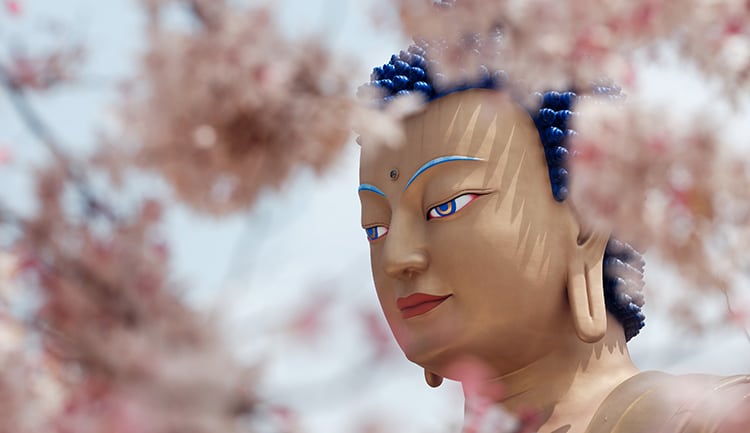Buddhist Meditation Techniques & Practices
Category: Buddhist Meditation | Buddhist Path | Popular | Types of Meditation

Summary: Buddhist meditation practices stem from the Buddha’s insights about existence: Shamatha (mindfulness) focuses on cultivating calmness, clarity, and equanimity, leading to inner peace and, when combined with vipassana (awareness), profound insights. Metta or lovingkindness meditation starts with cultivating well-being and lovingkindness towards oneself, then expands to encompass others. Contemplative meditation involves reflecting on fundamental Buddhist teachings, which encourage dedicated practice and mindful living. Guided Buddhist meditations can be helpful for beginners.
How Do Buddhists Meditate?
You probably know that the increasingly popular practices of mindfulness and meditation share Buddhist roots. But did you know that there are many different schools of Buddhism, each with its own meditation techniques and methods? This is because after the time of the historic Buddha, Siddhartha Gautama, in the 6th century BCE, Buddhism spread far and wide. As it spread, it adopted some of the characteristics and spiritual strengths of the lands where it became implanted.
All forms of Buddhism – and, by extension Buddhist meditation techniques – have arisen from the Buddha’s insights about the nature of existence, the causes of suffering, the causes of happiness, and guidelines for living a wholesome and constructive life. Buddhist meditation practices have now spread beyond the borders of the countries where they developed organically and are more widely available than ever before.
Tibetan visualization practices, Zen, vipassana, Pure Land, Nichiren and a number of other Buddhist forms of meditation are now taught and practiced all over the western world. Below we present 3 inspiring methods; if you explore a bit, you’ll surely find many more!
-
Shamatha
Shamatha (mindfulness) is a well-known Buddhist practice that focuses on developing calmness, clarity and equanimity. With the proper guidance and commitment, the cultivation of these qualities can ultimately lead to deep inner peace. When combined with vipassana (awareness) practices, it can lead to profound insights and spiritual awakening. The initial stages of mindfulness meditation are essentially non-denominational and can be practiced by anyone, regardless of their faith tradition.
The basis of shamatha, or mindfulness meditation, is as follows:
- Sit in a comfortable meditation posture: find a pose that doesn’t hurt your back or knees. Watch our Take Your Seat video or see our post to learn about the best Buddhist meditation postures. Keep your back straight and try to find a happy medium between too rigid and too relaxed.
- Observe your breath: You don’t have to manipulate your breath, use abdominal breathing or have long, deep in-breaths and out-breaths. Just breathe normally and pay attention to your breathing process, one breath at a time. Keep your awareness focused but be gentle; you should have an attitude of discovering and making friends with yourself.
- Acknowledge the thoughts that pop into your mind without engaging them. Simply observe them and let go. Come back to the breath. We call this “touch and go.” Let the thought arise, touch on it gently, and then let it go.
Check out our article on vipassana meditation for more information.
-
Metta or lovingkindness
Another popular method for how to practice Buddhist meditation is Metta, or lovingkindness, meditation. There are many different forms of this meditation as well. They begin with a period of śamatha to get the mind settled and receptive.
In one technique, we begin by directing wishes for well-being and lovingkindness toward ourselves. Then we open it out and direct lovingkindness towards a person or pet that we love. Then someone we feel neutral about, followed by somebody we have problems with or even an enemy. Ultimately our love flows equally towards all beings everywhere, regardless of how we feel about them. This form of meditation is about feeling the love and radiating out until the distinct edges that usually categorize us as “me, friend, enemy, etc.” fade away and what is left is benevolence, pure and simple.
We might repeat slogans or mantras that inspire our practice, such as “May my love for myself and others flow freely.” Or “May I and all living beings be safe, happy and peaceful.” A traditional Buddhist invocation called the four immeasurables starts with “May all beings find happiness and the cause of happiness. May they be free from suffering and the cause of suffering.” After a period of active metta practice, we sit in quiet awareness for a time. The full experience of this practice is highly transformative – take a course in the 4 immeasurables practice here.
-
Contemplative meditation
The Buddhist teachings share some fundamental beliefs. Practitioners are encouraged to reflect on them in a focused, contemplative manner. This contemplation may be integrated into a practice session. One of the best-known contemplations is called “The Four Thoughts that Transform the Mind.” Their purpose is to give us a good reason to sit down and practice rather than, for example, spend the next two hours on social media or in a shopping mall. These four thoughts, in brief, are:
- I can choose to devote my energy to developing wisdom, compassion and the power to benefit others. Many people in other situations, as well as other forms of life such as animals, don’t have this possibility. I recognize the preciousness of this opportunity and vow not to waste it.
- But who knows how long this precious life will last? Everything changes. My entire existence depends on an out-breath being followed by an in-breath. No time to waste!
- Everything that exists has a cause, and every action has consequences. This speaks to the truth of interdependence – and means that our actions have more of an impact than we might imagine.
- At one point or another, we will be separated from all of the material things we’re attached to. So much effort, so little lasting gain! Doesn’t it make more sense to focus our energy on being of benefit by developing the precious qualities of wisdom, compassion, and spiritual skills? May my meditation practice help me reach this goal!
Guided Buddhist Meditation
If you’re just starting your Buddhist meditation practice but aren’t quite sure how to go about it, try following a guided meditation. Mindworks Buddhist meditation courses offer a variety of guided meditations for meditators of all levels. Also check out our companion article What is Buddhist Meditation?
You might also join a local meditation class. It’s a great way to interact with other like-minded people and compare notes and tips. Now that we’ve answered the question “How do Buddhists Meditate?” it’s time to try it out for yourself. Have fun!








